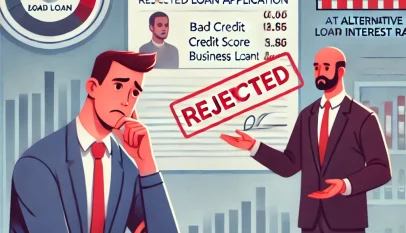How to Get a Business Loan with Bad Credit: Strategies for Securing Funding
Getting a business loan with bad credit can seem daunting, but it is possible with the right approach. Many lenders specialize in working with entrepreneurs who may not have perfect credit histories. Exploring alternative financing options and demonstrating a solid business plan is key to securing funds despite credit challenges.
There are several options available for those with bad credit. Personal loans, peer-to-peer lending, and microlenders can provide accessible financial solutions. Additionally, establishing a strong relationship with local banks or credit unions can yield more favorable terms.
How to Get a Business Loan with Bad Credit starts with preparing the necessary documentation and showing evidence of steady income to enhance approval chances. Business owners should focus on showcasing their unique value propositions and commitment to the venture. This can help persuade lenders to take a chance despite credit issues.
Understanding the Impact of Credit on Business Financing
Credit plays a significant role in business financing. Lenders use credit scores to assess risk, which directly affects the availability and terms of loans.
Exploring Credit Scores and Business Loans
Credit scores typically range from 300 to 850, with higher scores indicating better creditworthiness. For business loans, scores of 700 and above are often seen as favorable.
Lenders consider several factors within credit scores, such as payment history, credit utilization, and the length of credit history. Each factor contributes to the overall score.
A strong credit score can result in lower interest rates and better loan terms. Conversely, a weak credit score may lead to higher rates or even denial of the loan.
Challenges of Securing Loans with Bad Credit
Obtaining a loan with bad credit poses specific challenges for borrowers. Lenders may perceive these individuals as high-risk, leading to more stringent requirements.
Lower credit scores can result in higher interest rates, which increases the total repayment amount. Additionally, lenders might impose restrictive terms, such as shorter repayment periods or larger down payments.
Borrowers may explore alternative funding options, such as peer-to-peer lending or microloans. These may provide more accessible terms compared to traditional lenders.
Networking with local business groups or seeking guidance from financial advisors can also assist in navigating the loan process.
Strategies for Obtaining Business Loans with Poor Credit
Navigating the loan process with poor credit can be challenging. Implementing strategic steps can improve chances of securing financing, focusing on credit improvement, exploring alternative lenders, and crafting compelling business proposals.
Improving Personal and Business Credit Profiles
Enhancing credit profiles is essential. Individuals can start by checking credit reports for inaccuracies and disputing any errors. They should ensure all bills are paid on time and consider lowering credit utilization rates by paying down existing debts.
Business owners can also improve their business credit. This involves registering with credit bureaus and obtaining a Dun & Bradstreet number. Building trade credit with suppliers can contribute positively, so establishing relationships with vendors can lead to better creditworthiness.
Identifying Alternative Lenders and Loan Types
Traditional lenders often overlook applicants with poor credit. Exploring alternative lending options is key. Online lenders, credit unions, and peer-to-peer platforms may offer more flexible terms.
Small Business Administration (SBA) loans are also worth considering. While SBA loans have strict qualifications, they sometimes cater to applicants with less-than-perfect credit. Researching these options can unveil viable paths to funding.
Preparing Strong Business Plans and Proposals
Creating a robust business plan enhances loan applications. A clearly defined plan outlines business goals, market analysis, and financial projections. It demonstrates preparedness and credibility.
Including cash flow projections shows how the loan will be utilized. Providing evidence of prior business success or potential for growth can strengthen proposals. Personal narratives about overcoming challenges can further engage potential lenders.
British Virgin Islands Offshore Company Setup and Benefits Explained
The British Virgin Islands (BVI) is a leading offshore jurisdiction widely chosen for comp…














